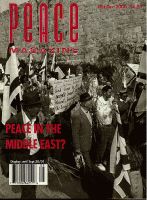
Peace Magazine Oct-Dec 2000, page 22. Some rights reserved.
Search for other articles by Eric Walberg here
In September 1997, the five Central Asian countries (Turkmenistan, Kyrgizia, Uzbekistan, Tajikistan, and Kazakhstan) signed a declaration to create the world's fifth nuclear weapons free zone, after Antarctica, Latin America (1963), and Southeast Asia (1995) and most of Africa (1996). There are other campaigns afoot, including a nuclear-free Transcaucasia and southern hemisphere, but the Central Asian treaty is the closest to implementation.
I spoke with Alla Karimova, head of the U.N. and International Political Organizations Division of the Uzbek Ministry of Foreign Affairs about the prospects of this development in nuclear disarmament.She is a graceful doctor of political science from the Russian Academy of Management in Moscow who formerly lectured at the Tashkent State University.
She attended the Nonproliferation Treaty Conference 2000 in May, with 155 member states and more than 140 research organizations and NGOs participating. The Uzbek delegation was one of the deputy chairs of the conference and a member of its general committee.The working document on the process of creating a nuclear weapons free zone in Central Asia (CANWFZ) was accepted as an official document of the United Nations by the conference.
Present status of negotiationsThere is already a project agreement which has been developed by the ongoing U.N.-sponsored group of experts from the five Central Asian countries. There is only one point of contention remaining, which they hope to settle soon. It has been difficult balancing the interests of all the Central Asian countries and the five official nuclear powers, Ms Karimova told me, but there is broad agreement among us. The nuclear powers must recognize our zone and give so-called negative guarantees not to violate our nuclear weapon free zone. I asked Ms. Karimova what is the point of a NWFZ now that Kazakhstan has destroyed its remaining nuclear weapons. She told me the zone addressed several vital issues. First, the nuclear explosions by Pakistan and India were upsetting to Uzbekistan. There are 30 countries that can or have tested nuclear weapons. Iran is a close neighbor to Uzbekistan and is rumored to be developing nuclear weapons.
Second, Uzbekistan sees itself as a vital force for nonproliferation of nuclear weapons. Already there are 120 states which are members of the four existing NWFZs in South America, Africa, and Southeast Asia. So far there are no such zones on the Eurasian continent or involving countries of the Organization for Security and Cooperation in Europe (OSCE). The Central Asian zone will be the first. Mrs. Karimova noted that the Central Asian zone, between Russia and China, is very significant geo-politically.
Finally, it is an important step in the prevention of nuclear terrorism. Pakistan is highly involved in Afghanistan, which is right on Uzbekistan's border. And Uzbek religious terrorists in Tajikistan and Afghanistan have been active lately.
In its "Patterns of Global Terrorism" report, the State Department added terrorist groups in Northern Ireland and Central Asia last year. The Central Asian group is the Islamic Movement of Uzbekistan (IMU), described as a coalition of Islamic militants from Uzbekistan and other Central Asian states opposed to the secular government of Uzbek President Karimov. This group is thought to be responsible for five car bombs in Tashkent in February and two hostage crises.
Openness of treatyMongolia recently declared itself to be a NWFZ and wanted to be a party to the treaty. However, the Central Asian countries have no common border with Mongolia and decided it was better to consolidate now rather than to expand.
Recently there has been talk of visa requirements for citizens of Central Asian countries travelling among the republics, which seems to be an indication that the countries are moving away from the spirit of integration which is implicit in the NWFZ and I suggested might hinder implementation of the treaty. However, Ms Karimova explained that "countries in other zones also require visas for travel between member countries. The visa regime is a temporary requirement introduced to help fight terrorism and smuggling."
There are unresolved claims on the Caspian Sea by the five countries bordering it. They solved this by simply excluding the sea from the treaty, including only the shoreline, which is not in contention.
The Japanese hosted conferences for the Central Asian countries in October 1999 and April 2000. The next meeting of the CANWFZ experts' group will take place in Samarkand this autumn.
The idea of the CANWFZ was first raised by Uzbek President Islam Karimov, who has made several other proposals to promote peace in the region. In particular, Uzbekistan hosted a conference recently of the six countries bordering Afghanistan plus the United States and Russia, to try to contain the civil war there. Last year at the OSCE Istanbul summit, he proposed setting up a centre against terrorism, which has received broad international support. Once a political backwater, Uzbekistan is taking on a new role internationally.
Mr.Walberg is a Canadian living in Tashkent.

Peace Magazine Oct-Dec 2000, page 22. Some rights reserved.
Search for other articles by Eric Walberg here